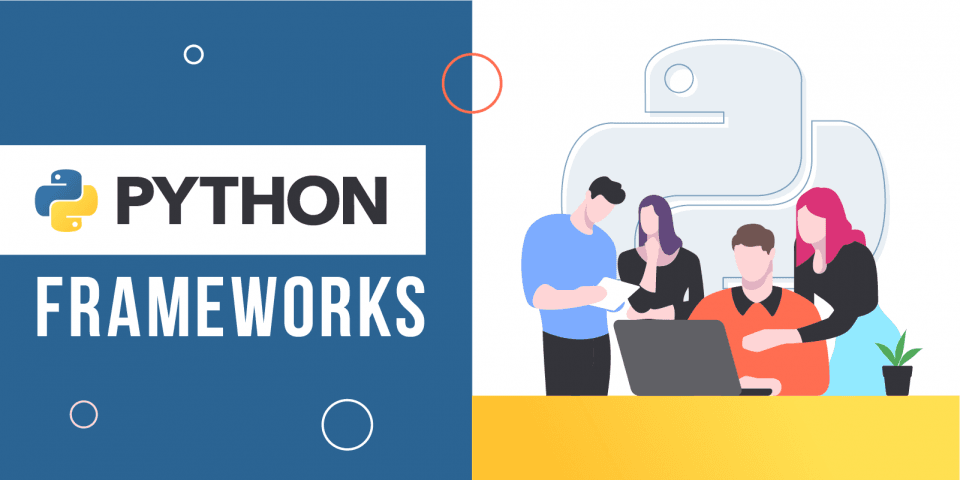What Python frameworks are worth your attention, and how to choose the right option? What should be taken into account? Let’s learn together!
Python frameworks: top options worth your attention
Python frameworks are diverse and numerous, so it may be pretty difficult to make the right choice. We have decided to make things clearer. In the following paragraphs, we present a panel of the five most used frameworks in 2023 that cover a wide range of features, ways of working, and, therefore, different applications.
You will be able to make an informed choice and carry out your project as efficiently as possible!
Django
Django is one of the major references in terms of Python frameworks. According to the 2020 Python Developers Survey, Django is the second most popular Python framework in the world. And it still remains incredibly popular and loved by millions. Just take a look at the apps built with django : they look incredible.
It is a free, extremely versatile framework that allows developers to create complex and very good systems.
Used by companies such as Amazon, Instagram, Pinterest, or Mozilla, Django is appreciated for its versatility and great speed of deployment. In addition, its large number of features allows developers to limit their coding time and reuse already written code.
Finally, Django is very well secured, making it a reliable framework, perfect for large-scale projects. To sum up, Django is fast, efficient, and safe; no wonder it appears first on our list!
Flask
Flask is a micro-framework available under a BSD license. Flask has been designed as a tool to create a solid web base for developers, which they could enrich as they wish.
Both flexible and versatile, Flask’s design makes it as practical for projects of large and small sizes. Its adaptability has made it Django’s main rival, so much so that it is common to use Flask by default when Django does not do the trick. In addition to its eclecticism, Flask is very easy to understand and handle. It is also compatible with the “Google App Engine,” which makes it an extremely practical framework.
Flask is used by companies such as Airbnb, Reddit, and Netflix, who appreciate Flask’s modular character, as it adapts to their developers’ needs.
Pyramid
Pyramid is an open-source web development framework. It is the most recognized framework among Python experts, who love it for the greatest flexibility and testability on the market.
Like Flask, Pyramid has a modular architecture, making it conducive to the development of projects of all sizes. However, Pyramid stands out from its competitor in its community support system.
Pyramid’s minimalist approach is also very central to the framework’s philosophy. This approach makes Pyramid dynamic and facilitates its applicability on a larger scale.
Pyramid is used by companies such as Thinkr, Kallibr, and Dropbox. It is a framework a little less easy to handle than its competitors but whose “s scalable” character makes it very attractive to developers. There is a community of nearly 3,000 participants.
Bottle
Fast, simple, and light: here are Bottle’s keywords. This micro-framework, originally created to construct APIs (application programming interfaces), is fast and incredibly easy to use.
One of the significant advantages of Bottle is that it allows you to work closely with the entire hardware part, making it a tool of choice to learn to prototype or to better understand how Python frameworks work in general.
Many companies take advantage of Bottle’s remarkable deployment speed to develop mobile applications, for example. In particular, we count Payasa Data and Sotong Kitchen as companies mainly using Bottle.
Tornado
Tornado is an open-source micro-framework created by FriendFeed and acquired by Facebook in 2009. Capable of supporting more than 10,000 connections simultaneously, Tornado is mainly used to process I/O operations.
Known for its high performance, Tornado produces quality results. Tornado also enjoys real-time services that allow greater assistance and optimal security.
Like Bottle, Tornado has only the essential features, which makes this framework a little less versatile than its competitors.
However, its user authentication service and its ability to control asynchronous networks make it a framework that cannot be used everywhere; it is quite specialized but remains very good.
Conclusion
As you have understood, choosing a framework for Python is not a task to be taken lightly. The best option is to contact a development company; experienced professionals will help you choose the right tech stack at the project discovery phase.
Choosing the right Python framework means considering its qualities, defects, and degree of adequacy with the project you want to carry out. This is essential to produce a quality result eventually.
With Django, Flask, Pyramid, Bottle, and Tornado, you have a range of frameworks known and recognized by developers worldwide, allowing you to carry out the vast majority of your web development projects in the most efficient and productive way possible.
SECL experts have years of experience utilizing Python frameworks in diverse projects, so you are guaranteed to get a high-quality product that meets all your expectations.
